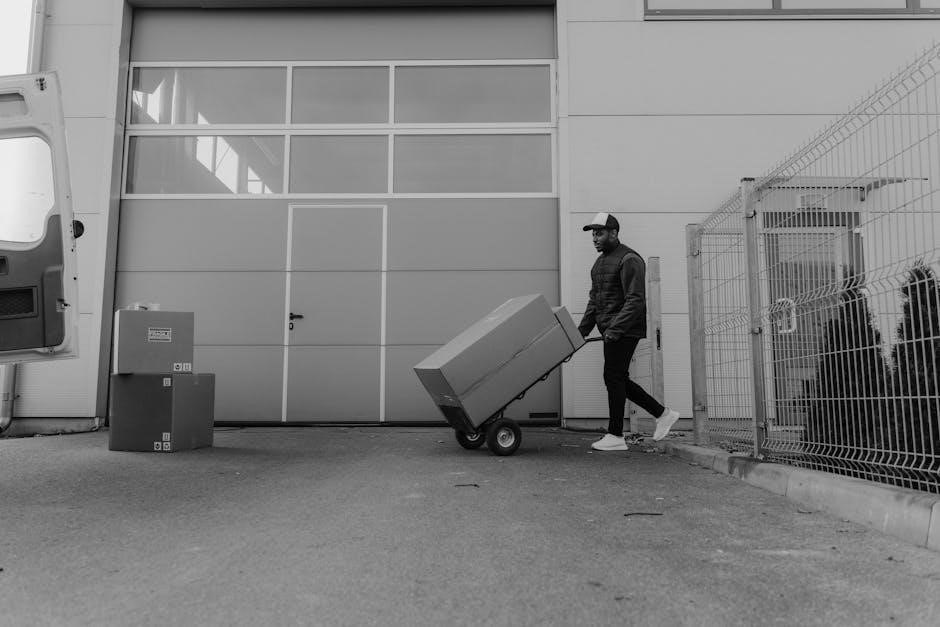
manual garage door won’t open from outside
Is your manual garage door stuck? Learn how to diagnose and fix the issue quickly with our expert guide. Get your door working smoothly again!
A manual garage door that won’t open from outside can cause significant inconvenience and safety concerns. Common issues include track misalignment, broken springs, or lock engagement problems.
1.1 Understanding the Problem
When a manual garage door fails to open from outside, it often stems from mechanical issues like misaligned tracks, broken springs, or a malfunctioning lock. Identifying the root cause is essential for effective troubleshooting and ensures safety while resolving the problem.
1.2 Importance of a Functional Garage Door
A functional garage door is crucial for security, convenience, and property protection. A door that won’t open from outside can pose safety risks, especially in emergencies. Regular maintenance ensures smooth operation, preventing potential damage and prolonging its lifespan. Addressing issues promptly avoids further complications and ensures reliable access to your garage and belongings. A well-maintained door also enhances home security and safety, making it essential to resolve any operational problems quickly.

Common Causes of the Problem
Track misalignment, broken or tensioned springs, obstructions, and lock engagement issues are common reasons a manual garage door won’t open from outside, requiring immediate attention.
2.1 Garage Door Lock Engagement
A common issue is the garage door lock being accidentally engaged or malfunctioning, preventing the door from opening. If the lock is stuck or jammed, it can block the door’s movement. Check the lock mechanism to ensure it is fully disengaged. If the keyhole is jammed, try cleaning it gently. Never force the lock open, as this could cause further damage. Ensure the lock is properly aligned with the door frame for smooth operation. Addressing the lock engagement is often the first step in resolving the issue.
2.2 Manual Release Mechanism Issues
Issues with the manual release mechanism can prevent the door from opening. The emergency release cord may be stuck or damaged, or the mechanism itself could be misaligned. If the cord is pulled too forcefully, it might break or disengage improperly. Additionally, if the mechanism is not regularly maintained, rust or debris can cause it to jam. Always ensure the release is properly engaged and aligned to avoid such problems. Regular lubrication can help prevent rust and ensure smooth operation.
2.3 Broken or Tensioned Springs
Broken or overly tensioned springs are a common cause of a manual garage door refusing to open. Torsion or extension springs bear the door’s weight and facilitate smooth operation. If a spring breaks, the door becomes unbalanced, making it impossible to open. Overly tight springs can also prevent proper movement. Attempting to force the door open may worsen the damage. Always inspect springs for visible breaks or uneven tension. If damaged, professional replacement is recommended to ensure safety and proper functionality.
2.4 Obstructions in the Tracks
Obstructions in the tracks are a frequent issue causing a manual garage door to malfunction. Debris, dirt, or misaligned rollers can block the door’s path, preventing smooth operation. If the tracks are clogged or dented, the door may jam or refuse to open. Regular inspection and cleaning of the tracks are essential to ensure proper movement. Misaligned rollers or excessive wear can also disrupt functionality. Addressing these issues promptly helps maintain the door’s performance and longevity, ensuring it opens effortlessly from outside.
Step-by-Step Troubleshooting
Troubleshooting a manual garage door that won’t open involves checking the lock, manual release, springs, and tracks. Lubricate moving parts and ensure proper alignment for smooth operation.
- Inspect the garage door lock for engagement issues.
- Check the manual release mechanism for proper function.
- Examine springs for damage or tension problems;
- Clear debris from tracks and realign rollers if necessary.
3.1 Checking the Garage Door Lock
Start by inspecting the garage door lock to ensure it is fully disengaged. A locked door won’t open, even when using the manual release. Check for a jammed keyhole or misaligned locking mechanism. If the lock appears engaged, try disengaging it manually or with a key. Ensure no obstructions prevent the lock from releasing properly. If the lock is damaged or rusted, consider lubricating it or replacing it if necessary. A functional lock is essential for smooth door operation.
- Visually inspect the lock for engagement.
- Check for obstructions in the keyhole.
- Test the lock’s operation manually.
3.2 Inspecting the Manual Release
Locate the emergency release cord, typically hanging from the opener. Pull it gently to disengage the door from the opener. Check for tangles, damage, or improper connection. Ensure the cord operates smoothly and fully releases the door. If the manual release is stuck, lubricate it or replace it if damaged. Proper function ensures safe and easy door operation when needed.
- Find and pull the emergency release cord.
- Check for tangles or damage to the cord.
- Ensure proper connection and smooth operation.
3.3 Examining the Tension and Torsion Springs
Inspect the tension and torsion springs for visible damage, rust, or misalignment. Torsion springs are mounted above the door and should be tightly wound, while tension springs are attached to the door’s sides. Look for breaks or gaps in the coils. If springs are damaged, the door may not open smoothly. Lubricate them if corroded, but avoid attempting repairs without proper tools, as springs are under high tension and pose safety risks.
- Check for visible breaks or rust on springs.
- Ensure proper alignment and tension.
- Lubricate corroded springs carefully.
- Avoid DIY repairs due to safety risks.
3.4 Looking for Track Misalignment or Damage
Inspect the garage door tracks for misalignment, dents, or obstructions. Check both the vertical and horizontal sections for proper alignment. Signs of misalignment include the door hanging unevenly or making grinding noises. Use a level to ensure tracks are straight and secure. If damaged, gently hammer out dents or tighten loose brackets. Misaligned tracks can prevent the door from opening smoothly, so adjusting them may resolve the issue. Ensure all rollers are properly engaged within the tracks for smooth operation.
- Check for dents or obstructions in tracks.
- Verify alignment with a level.
- Adjust or tighten brackets as needed.
- Ensure rollers are fully engaged.

Fixing the Garage Door Lock
Common issues include a jammed keyhole or misengaged lock. Check for obstructions and ensure the lock is fully disengaged. Lubricate the mechanism with silicone spray if stuck.
4.1 How to Disengage the Lock
Start by locating the lock mechanism and ensuring the door is fully closed. Insert the key into the keyhole and gently turn it counterclockwise. If the lock doesn’t disengage, apply a small amount of silicone-based lubricant to the keyhole. Allow it to sit for a few minutes before attempting again. Avoid using force, as this could damage the lock or surrounding components. If the issue persists, consider consulting a professional locksmith or adjusting the lock alignment. Ensure all parts are clean and free from debris for smooth operation.
4.2 Addressing a Jammed Keyhole
If the keyhole is jammed, start by inspecting for debris or rust. Apply a small amount of silicone-based lubricant or WD-40 to the keyhole. Let it sit for a few minutes to allow the lubricant to penetrate. Gently insert the key and turn it slowly. Avoid using force, as this could break the key or damage the lock. If the issue persists, consider consulting a professional locksmith to avoid further damage. Regular cleaning of the keyhole with a small brush or cloth can prevent future jams.

Addressing the Manual Release
Locate the emergency release cord, usually hanging from the opener. Pull it gently to disengage the door from the opener. Check for obstructions or misalignments. Lubricate moving parts regularly to ensure smooth operation and prevent jams. Proper maintenance can prevent future issues and ensure the manual release functions effectively when needed.
5.1 Locating the Emergency Release Cord
The emergency release cord is typically hanging from the garage door opener. It is usually red or brightly colored for easy identification. Locate it by visually inspecting the opener mechanism. Once found, gently pull the cord to disengage the door from the opener. This allows manual operation. Ensure no obstructions are present before attempting to open the door. Regular inspection of the cord’s accessibility and condition is essential for smooth operation.
5.2 Properly Engaging the Manual Release
Once the emergency release cord is located, gently pull it down to disengage the door from the opener. Ensure the door is fully closed before engaging the manual release. After disengaging, check for obstructions and manually lift the door. Always ensure the area is clear before opening to avoid accidents. Regular inspection of the release mechanism ensures smooth operation and prevents future issues. Proper engagement allows safe manual operation when needed.

Repairing Broken Springs
Broken springs are a common issue, requiring immediate attention. Identify damage, safely replace torsion springs, and adjust tension springs to restore proper door function and safety.
6.1 Identifying Spring Damage
Identifying spring damage is crucial for safe repairs. Look for visible gaps, rust, or broken coils on torsion or tension springs. If springs are worn or snapped, they must be replaced immediately to avoid further damage or safety hazards. Always inspect from a safe distance and avoid touching damaged springs, as they can cause injury. Professional assistance is recommended if unsure about the extent of the damage.
6.2 Safe Replacement of Torsion Springs
Safely replacing torsion springs requires caution due to their high tension. Disconnect the garage door from the opener and secure it with clamps. Wear protective gear, including gloves and safety glasses. Use a wrench to carefully release tension from the spring. Remove the old spring and install the new one, ensuring proper alignment. Tighten the bolts securely and test the door’s balance. If unsure, consult a professional to avoid accidents.
6.3 Adjusting Tension Springs
Adjusting tension springs is crucial for ensuring smooth operation. Start by disconnecting the door from the opener and securing it with clamps. Use a wrench to tighten or loosen the springs slightly, testing the door’s balance after each adjustment. Over-tightening can cause damage, so proceed cautiously. Apply silicone-based lubricant to moving parts after adjustment. Always wear safety gloves and eyewear. If unsure, consult a professional to avoid potential hazards.

Clearing Track Obstructions
Inspect tracks for debris, dirt, or misalignment. Remove obstructions and ensure rollers align properly. Use a level to check track alignment and adjust if necessary. Lubricate tracks for smooth operation and ensure the door closes fully without resistance. Regular maintenance prevents future issues and ensures safe functionality.
7.1 Inspecting the Tracks for Debris
Start by visually examining the garage door tracks for debris, dirt, or grease buildup. Use a flashlight to spot obstructions in both horizontal and vertical sections. Common issues include leaves, dust, or even spider webs. Clean the tracks with a soft cloth or brush to remove any blockages. Ensure the tracks are properly aligned using a level. Misaligned tracks can prevent the door from opening smoothly. Regularly inspecting and cleaning the tracks helps maintain smooth operation and prevents future issues.
7.2 Re-aligning the Door Rollers
Re-aligning door rollers is crucial for smooth operation. If rollers are misaligned, gently adjust them using a wrench or pliers. Ensure they are securely seated within the tracks without forcing them. Check for bent or warped tracks, as these can prevent proper alignment. Lubricate the rollers and tracks to reduce friction. If rollers are damaged or worn, replace them immediately. Misaligned or damaged rollers can cause the door to bind or stick, making it difficult to open from the outside. Regular checks help maintain proper alignment and functionality.
Lubrication and Maintenance
Regular lubrication of hinges, rollers, and springs is essential for smooth operation. Use silicone-based lubricants every 6-12 months to prevent stiffness and wear. Maintain proper alignment and inspect moving parts regularly to ensure functionality and safety.
8.1 Importance of Regular Lubrication
Regular lubrication is crucial for maintaining smooth operation of a manual garage door. Silicone-based lubricants reduce friction, prevent rust, and protect moving parts like hinges and rollers. Lubricating every 6-12 months ensures parts move smoothly, prevents sticking, and avoids wear. Overlooking lubrication can lead to increased friction, rust, and potential failure of components. Proper lubrication also helps maintain balance and ensures the door operates safely and efficiently, preventing costly repairs. Clean parts before applying lubricant to maximize effectiveness.
8.2 Recommended Lubricants for Garage Doors
Silicone-based lubricants are highly recommended for garage doors due to their effectiveness in reducing friction and protecting moving parts. White lithium grease is another excellent option for metal components. Avoid using WD-40, as it can attract dust and dirt, leading to further issues. Powdered graphite is ideal for hinges and rollers, ensuring smooth operation. Always choose lubricants specifically designed for garage doors to maintain durability and performance. Proper application ensures longevity and prevents mechanical failures.

Additional Tips for Manual Garage Doors
Regularly inspect moving parts like rollers and springs for wear. Ensure proper alignment to prevent strain and ensure smooth operation. Lubricate hinges and tracks annually.
9.1 Regular Inspection of Moving Parts
Regularly examine rollers, hinges, and springs for wear or damage. Lubricate hinges and tracks with silicone-based lubricants every 6-12 months to ensure smooth operation. Check for misalignment or obstructions in tracks, as these can hinder door movement. Inspect cables and springs for signs of fraying or tension issues, addressing them promptly to prevent sudden failures. Consistent maintenance helps avoid unexpected malfunctions and ensures reliable door functionality over time.
9.2 Checking for Proper Alignment
Ensure the garage door tracks are properly aligned and not bent or warped. Misaligned tracks can cause the door to jam or stick, preventing smooth operation. Visually inspect the tracks for straightness and check that all rollers are securely seated within them. If misaligned, gently adjust the tracks or consult a professional for precise realignment. Proper alignment ensures the door moves effortlessly, reducing wear on moving parts and preventing potential damage. Regular checks help maintain optimal functionality and safety.

When to Call a Professional
Call a professional if issues like broken springs, severe track damage, or complex lock problems arise. They ensure safety and proper repairs, preventing further damage or injury.
10.1 Recognizing Complex Issues
Complex issues with a manual garage door that won’t open from outside often involve severe damage or advanced mechanical problems. These include broken or tangled cables, severely misaligned tracks, or a door that has come off its tracks entirely. Additionally, if the torsion or tension springs are snapped or excessively worn, professional intervention is necessary. Such problems require specialized tools and expertise to fix safely and effectively, ensuring the door operates smoothly and securely afterward.
10.2 Safety Precautions for DIY Repairs
When attempting DIY repairs, always prioritize safety. Disconnect power to the opener and ensure the door is secure before starting work. Wear protective gear, such as gloves and safety glasses, to guard against sharp edges or falling debris. Never attempt to lift or adjust heavy components like springs without proper tools, as they can cause severe injury. If unsure about a repair, consider consulting a professional to avoid accidents and ensure the door operates safely and efficiently.